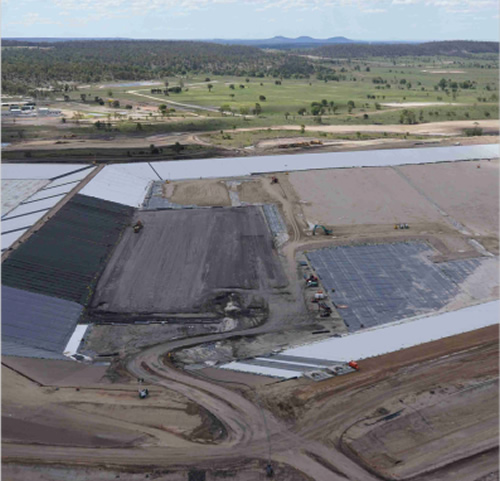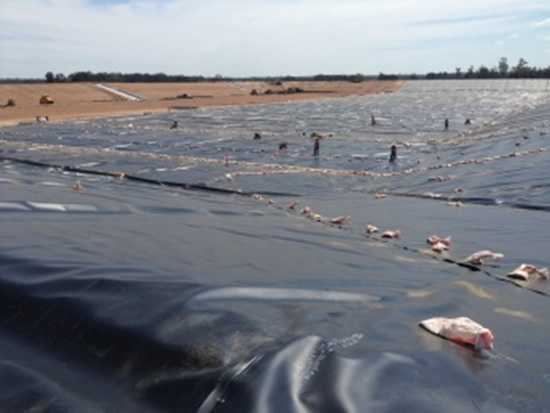Editor’s Introduction: This coal seam gas article was first published 20 July 2016 on Geosynthetica. We re-release it here in honor of the author, Fred Gassner, being awarded Honorary Membership with the Australasian Chapter of the International Geosynthetics Society (ACIGS). Gassner helped found the ACIGS 20 years ago.
Brine Ponds for Coal Seam Gas Operations
By Fred Gassner – In the past decade, Australia has developed large coal seam gas (CSG) resources. Golder has been closely involved in the water management part of this development, with the temporary storage of shallow groundwater that is liberated as part of the gas extraction process. The groundwater is saline and the soils generally are highly dispersive so most of the extracted water is stored in lined ponds. The extracted water is then pumped to agglomeration ponds where the water is treated through reverse osmosis plants and the brine deposited in enhanced lined ponds. The clean water is re-used for other beneficial uses. We have designed a large number of lined ponds for various CSG operators, with most of our services including full-time construction advice and quality assurance services during construction.
Pond sizes varied from 5 ML temporary ponds to more than 1200 ML ponds, with a large number of 300 – 500 ML ponds.
Some coal seam gas operators have taken the water beneficiation process a step further by introducing thermal evaporators of the brine to form supersaturated hot brine, and extracting most of the remaining water in the brine for beneficial reuse.
MORE CONTAINMENT: An Arctic Project: QC and Leak Location of a Bituminous Liner
We have designed two large (in excess of 1000 ML) ponds to store the hot supersaturated brine. The operating environment of these ponds are particularly challenging for a geosynthetics team, given the high temperature and the aggressive nature of the brine. A description of those systems follows.

CONSTRUCTING LARGE COAL SEAM GAS PONDS
The supersaturated brine ponds were comprised of dual composite liners, secondary seepage collection, and leakage collection systems, requiring specific fortified geosynthetics to provide the required design life. Various materials were tested in laboratory accelerated degradation processes in a local geosynthetics laboratory in Melbourne to determine which specific products were likely to meet the design intent. Initial input on possible geosynthetics materials was sought from global manufacturers. A number of materials were considered but a wide selection of polyethylenes became the right choice due to cost. Testing of a special formulation of high-density polyethylene suggested that it is likely to meet the design life of the ponds.

The other infrastructure in the ponds included insulated epoxy lined concrete structures and very high grade stainless steel chutes. Also, we constructed one of the ponds as a turnkey project for the client. The work included a spent ion exchange pond. Both ponds were delivered on budget and ahead of schedule.
CSG QUALITY CONTROL
To improve the service to our clients, we have developed a dynamic real-time electronic quality control system for the quality assurance of the installed geosynthetics and related earthworks. This is a system that operates on a tablet, and brings together all the manufacturing, installation and testing data on a GIS based platform. This allows the quality assurance staff to actively verify that the installed works have used approved materials, all seams and repairs have welded or joined, and been tested in real time. This was particularly important for the multilayer systems, where layers needed to be approved before subsequent layers are placed, and the multilayer system was required to be installed as a continuous sandwich system due to access constraints.
The experience and knowledge developed from some of these projects have been published in a number papers presented in various International Geosynthetics Society-related (IGS) conferences in the past few years.
Fred Gassner is a Principal at Golder Associates. He can be contacted on +61 414 909 701 or fgassner@golder.com.au.












